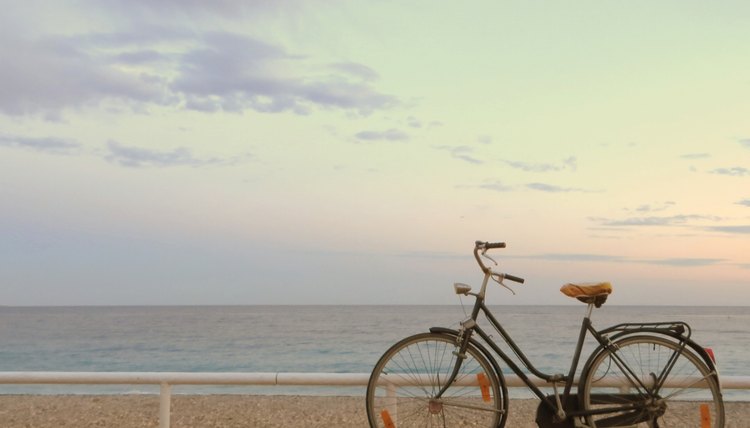How to Put Front Brakes on a Cruiser Bicycle

The majority of cruiser bikes come with a single coaster brake at the rear wheel. The casual nature of cruising possibly has resulted in status-quo production by manufacturers. But, there are places, such as steep hills or quick-stop situations, when additional braking is beneficial. Installing front brakes on a cruiser bike is not complicated. Bike shops carry adapter kits that include center-pull or U-brake caliper brakes and pads, a universal bracket, hand lever and a brake cable. Installation requires a couple of hand tools along with the instructions for the particular front brake kit.
Brake Arms Installation
Place the brake arm assembly and brake pads on a workbench or worktable. Install the brake pads against the inside face of each brake arm with the threaded studs facing out. Screw the crown nuts onto each stud by hand. Rotate the pads so they are perpendicular to the brake arms and tighten the crown nuts with a metric wrench.
Park the cruiser bike on its kickstand. Attach the universal bracket to the front of the steering headset using the bolt and rear clamp from the kit. Tighten the bolt just enough so the bracket stays in place and can be moved up or down by twisting it from side to side.
Unscrew the hex nut from the end of the pivot bolt that holds the brake arms together. Place the nut and a metric wrench near the front wheel of the bike. Spread the caliper brake arms fully open by hand.
Slide the brake arms over the front fender and tire and align the brake pads with each side of the wheel rim. Move the caliper against the bracket and push the end of the pivot bolt into the lower hole. Thread the saved nut on the end of the pivot bolt behind the face of the bracket. Tighten the nut with your wrench.
Check the alignment of the brake pads with the wheel rim. Move the bracket up or down as needed so the inside faces of the pads align with the center of the wheel rim. Tighten the clamp bolt to secure the bracket in place.
Lift the center of the short pull-brake cable that attaches between the upper ends of the brake arms. Slide the cable stay onto the front of the cable. Thread the short Allen screw through the hole in the stay and into the end of the short stud on the face of the bracket. Tighten the screw with an Allen wrench.
Hand Lever and Brake Cable
Position the brake hand lever on the handlebars so the housing is against either handgrip. Hold the half-clamp in place at the underside of the housing with one hand. Thread the Allen screws into the clamp from below and into the underside of the hand-lever housing. Tighten the screws with the Allen wrench. You can readjust the angle of the hand lever to your liking before riding the bike.
Refer to the adapter kit instructions and connect the ball end of the brake cable to the hand lever.
Insert the stranded end of the cable through the cable port in the top of the bracket and fully into the cable stop on the left brake arm. If necessary, loosen the cable-stop screw with the Allen wrench to insert the cable into the stop so the end protrudes below the cable stop.
Compress the brake hand lever against the handgrip and leave it in this position. Grip the end of the stranded cable below the cable stop with locking pliers. Pull the end of the cable straight down until the hand lever opens fully. Continue to hold downward pressure on the cable.
Squeeze the brake arms together by hand so the inside face of each brake pad is 1/8 inch from the corresponding side of the wheel rim. Tighten the cable-stop screw securely with the Allen wrench. Release the pliers from the cable.
Tips
Adapter kit components and installation vary by kit. Always follow the provided instructions.
Warnings
By changing any component on your bike, including the brakes, you may void the bicycle's warranty. Read the conditions of the warranty or check with your dealer before changing the brakes.
References
Warnings
- By changing any component on your bike, including the brakes, you may void the bicycle's warranty. Read the conditions of the warranty or check with your dealer before changing the brakes.
Writer Bio
William Machin began work in construction at the age of 15, while still in high school. In 35 years, he's gained expertise in all phases of residential construction, retrofit and remodeling. His hobbies include horses, motorcycles, road racing and sport fishing. He studied architecture at Taft Junior College.
